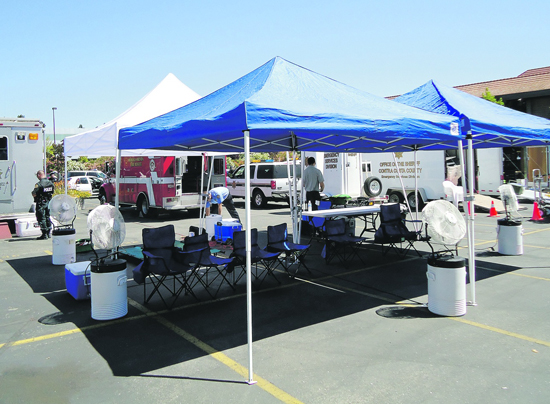
| ||||||
"Firefighters will spend large amounts of energy, body heat and fluids in order to cool the body," says MOFD Battalion Chief Darrell Lee. "The problem is we wear firefighter's clothing that doesn't allow the body to cool or evaporate sweat. During emergencies, wildland fires and structure fires, we are prone to heat exhaustion or heat stroke." Rehab 41 allows MOFD firefighters and any on-scene emergency personnel to find a quiet spot to rest and rehydrate before going back into the fray.
The Occupational Safety and Health Administration (OSHA), requires that emergency personnel receive rapid treatment, re-hydration and medical monitoring during emergency operations or training exercises.
For some Districts this can simply mean portable fans and an ice chest full of waters. In a District with remote locations and the threat of sustained wildland fires a real possibility, MOFD developed the idea of a comprehensive unit to best serve their emergency personnel. With that in mind, the District spent the last eight years outfitting a retired ambulance, starting with the basics of water and medical equipment, then slowly adding additional items such as pop-up canopies, misters with fans, coolers, chairs, coffee pots and even blenders for fruit smoothies. Today, Rehab 41 is the only self-sufficient medical/rehabilitation unit in Contra Costa County.
For years, Rehab 41 was staffed by MOFD's paid reserves. According to Lee, these reserves held this support role during local emergencies as MOFD responded to working fires, second alarms or wildland fires. Because of budget cuts, the reserve program was eliminated last year and Lee suggested using its existing all-volunteer group, the Communication/Logistics Support Team, to man Rehab 41.
These volunteers were then trained to drive the ambulance, learned the medical/rehab protocol, and, during incidents, would remain with the unit until released by the incident commander. While medical supplies are part of Rehab 41's supply list, only EMT's or other medically-trained personnel would utilize them, not volunteers.
Rehab 41 volunteer Marty Heyman says that this unit is called into action about six times a year. Volunteers are contacted by the District and, while there is no official 'on call' list, finding members to staff the truck is never an issue. "All of our volunteers are in the Lamorinda area so we can get to the station quickly," says Heyman, adding that volunteers range from retirees to presidents of software companies: "This team is made up of committed community volunteers who get a tremendous amount of satisfaction helping MOFD."
"The MOFD Communications/Logistics Volunteer Group is a very important component of our overall emergency response program," said MOFD Fire Chief Randy Bradley. "The expertise and dedication they bring to the table enhances our ability to provide the expected service levels that our communities deserve."
Rehab 41, which is housed at MOFD's station 41 in Moraga, has also been utilized by various agencies throughout the county for both training activities and emergency response. Lee said that during the fatal accident on Camino Pablo, Rehab 41 was a vital support system. "This was an incident that had 80 people working for over ten hours," he said. "Rehab support was able to provide water, coffee, food and a rest place for emergency workers. Fire, police, public works and PG&E all used the area to take a break during the accident."
Reach the reporter at:
Copyright
